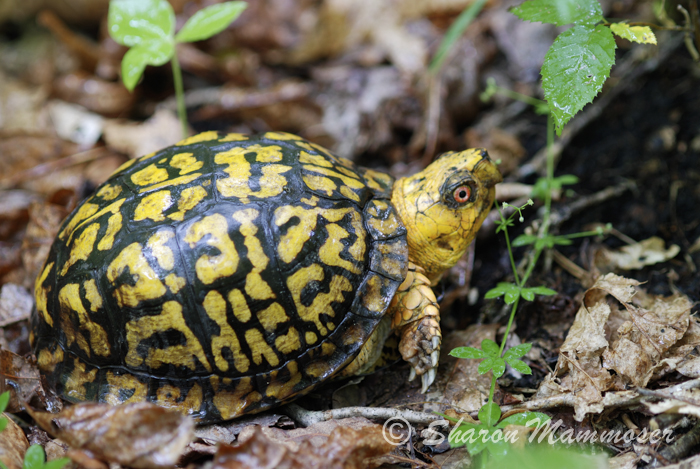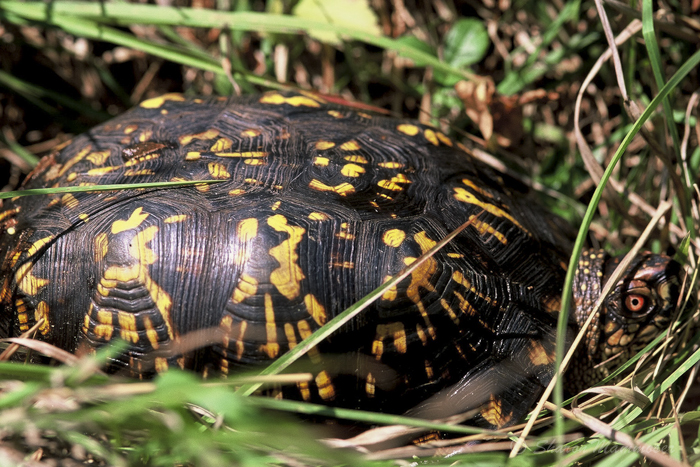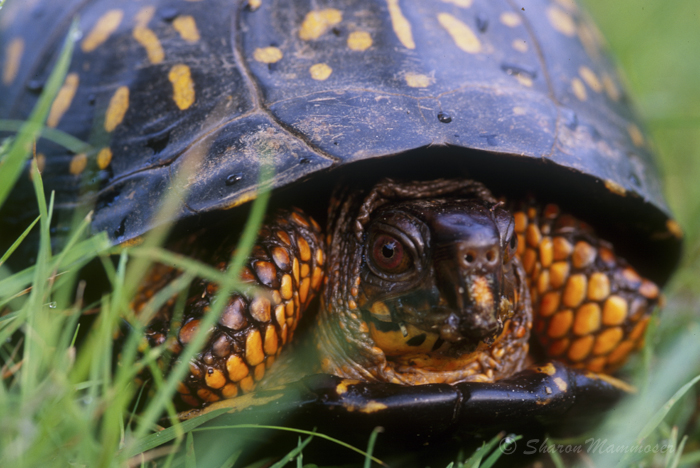 Years ago I worked as a Naturalist at a nature center in a 4700 acre park in eastern New York State. I loved this park, especially all of the lovely meadows that lined the roads. It wasn’t unusual to find me there on my days off or more likely, in the early morning hours before I had to clock in to work. There was one field in particular that on cloudy or rainy mornings in the summer I often came across box turtles–the most common terrestrial turtle in the United States. They were fun to watch as they meandered about and though I often tried to take their picture, many were not fond of this, pulling their heads in and tightly closing their shells. But wait! I wanted to photograph their eyes, not just their shells! Then it was a contest between us on who had more patience. In general, I think the turtles won, as I would get distracted by something else interesting and wander off, leaving the turtle alone and free to wander without being watched.
Years ago I worked as a Naturalist at a nature center in a 4700 acre park in eastern New York State. I loved this park, especially all of the lovely meadows that lined the roads. It wasn’t unusual to find me there on my days off or more likely, in the early morning hours before I had to clock in to work. There was one field in particular that on cloudy or rainy mornings in the summer I often came across box turtles–the most common terrestrial turtle in the United States. They were fun to watch as they meandered about and though I often tried to take their picture, many were not fond of this, pulling their heads in and tightly closing their shells. But wait! I wanted to photograph their eyes, not just their shells! Then it was a contest between us on who had more patience. In general, I think the turtles won, as I would get distracted by something else interesting and wander off, leaving the turtle alone and free to wander without being watched.
Here are some things I learned about Eastern Box Turtles from my observations and from my reading:
1. The most interesting thing I learned about box turtles is that the females can store sperm for up to 4 years after a single mating and can produce viable eggs during this time though the longer she goes without mating again, the less eggs she may produce.
2. Box turtles are long lived reptiles. They live 30-40 years in the wild. Their numbers are declining though in much of their range, due to loss of habitat, habitat fragmentation, accidents with vehicles and from people claiming them pets. Please don’t do this! It may not seem like much–taking ONE turtle from the wild, but in reality it can have devastating consequences for the population as a whole. Turtles don’t reach sexual maturity until 7-10 years or more. Wild turtles stolen from the woods and kept as pets will never add to the gene pool. Also, box turtles have an incredible homing instinct… thus when a child gets tired of the turtle and “lets it go,” the turtle is likely destined for death as it will try to return to the place it was born, encountering a slew of challenges along the way. 
3. Box turtles are dormant (inactive) during the winter, as deep as two feet under ground. They may use an old mammal burrow, a fallen log, stick pile or will dig a depression of their own using their hind feet. They might return each year to use the same hibernaculum and may share it with other individuals.
4. Box turtles get their names from the fact that they can close up their shell completely, so tightly in fact that a knife blade can’t even get inside. Other turtles, like painted turtles and snapping turtles do not have this ability. Interestingly, the shell of a box turtle is actually its ribcage!

5. In their younger years, box turtles are more carnivorous, feeding on snails, slugs, worms, insects, spiders, etc. As they age, their diet becomes more herbivorous, feeding on fruit and berries, and leaves. Box turtles also eat carrion (dead animals) and mushrooms, including poisonous ones that do them no harm. People who eat box turtles can get sick from the poisonous mushrooms the turtle ate.
6. Box turtles inhabit woodlands, and marshy meadows, foraging in the morning hours when it is still cool or on rainy days. On hot days they might soak in puddles or bury themselves in leaf litter in the shade of a forest.

7. The top of a turtle’s shell is called the carapace. The carapace is covered with plates that are called scutes. Each year a box turtle gets a new ring on each of its scutes, in the same way a tree gets a new ring for each year’s growth. So if you find a turtle in the woods that has scutes filled with tightly packed rings, you can figure it’s an old turtle. Is is not an accurate way to determine the age of the turtle however since rings may be lacking in years when food was scarce and rings overlap once the turtle reaches about 15 years of age.

8. Eastern Box turtles are the state reptile of North Carolina and Tennessee.

9. Male box turtles tend to have red or orange eyes whereas females have brown eyes. Males also tend to be more colorful, have longer front claws, thicker and longer tails and their plastron (bottom part of the shell) is concave whereas a female’s plastron is flat or flatter. Young turtles may not always show these indicators so sexing them can be more challenging. Male box turtles have a concave plastron (bottom part of their shell) so that he can accommodate the dome of her shell during copulation. If he falls during this process and ends up on his back and cannot get righted, he may stave to death.
10. An interesting fact about box turtles is that the sex of the turtles is affected by the temperature of the eggs. Box turtles mate between May and October with the females then laying 3-6 elliptical eggs in holes that they dig in sandy soil. The eggs will incubate for 2-3 months before hatching out. Eggs that are warmer in temperature, for instance, less deep in the hole, will become females. Those eggs that are cooler, for instance, towards the bottom where it is colder, become males. The young turtles may overwinter as eggs. When the turtles are first born, they cannot close their shells completely like the adults, putting them at a disadvantage against predators like raccoons, fox, coyotes and bobcats.
What to do if you find a turtle crossing the road: If you encounter a box turtle or any turtle crossing the road and want to help, the best thing you can do is to take the turtle IN THE DIRECTION IT IS HEADED and then set it down. Putting it back on the side it was coming from will only make the turtle have to cross the road again. Taking it to another location and letting it go will also be bad as turtles have incredible homing instincts that cause they to try again and again to return to the place where they were born.
Happy Turtle watching!

